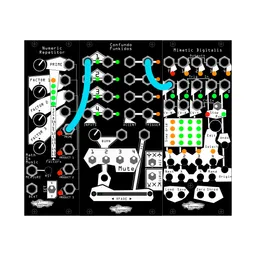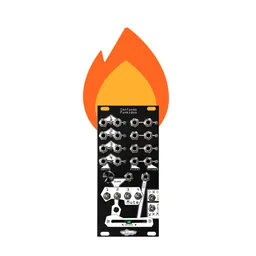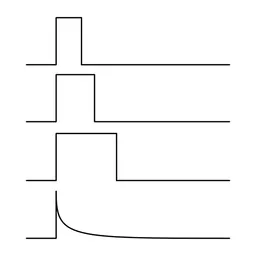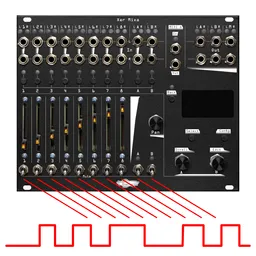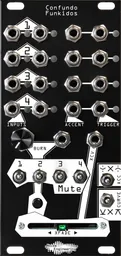One of the greatly expanded features on the new Confundo Funkidos is Burn. The original Confundo Funkitus had a simple button that was all-or-nothing when it came to fills, but we added a CV-controllable potentiometer and added a mute behavior for Burn when we reimagined the Funkidos. Today, we’ll explore the subtleties of Burn and explore how you can dial in the exact fills you want.
What does Burn do?
Before we explore using Burn in a performance, let’s take a moment to explore how it works. The potentiometer is split in half: the lower half changes trigger routing probability, and the upper half changes accent probability.
When set to minimum, what you see is what you get: triggers and accents are output based on crossfader position and accent setting.
As you turn Burn up to noon, there’s an increasing probability that a trigger at any of the eight inputs will be routed to any of the four trigger outputs. Settings below noon are particularly useful for interspersing random triggers that are in-sync with the rest of your pattern.
Past noon, all triggers are routed to all the outputs, and Burn starts to apply probability to the Accent outputs. The more it’s turned up, the higher the likelihood that an Accent output will change state (that is, go from low to high or from high to low).
Holding down the Burn button will set Burn to maximum: all triggers will go to all outs, and accents will always flip state. And the Burn potentiometer can be CV controlled for even more fun with LFOs and sequencers!
The three-position mute switches also interact with Burn: when in the center position, the Mute switches eliminate their respective channel from Burn (and also mute their Accent outputs). For example, I like to put my kick drums on channel 1, so I often use channel 1’s Mute to remove it from the Burn mix. This way, I can add some wild fills to my other percussion voices without having too many blast beats in my drum mix.
Burn in action
Burn was designed initially as a performance tool. Use the button to bring in instant, exciting fills, or dial in increasingly chaotic rhythms with careful use of the potentiometer.
Setting Burn to a low setting – like 8 or 9 o’clock – is a great way to add some occasional extra triggers to your sequence, too. The extra triggers will always be in-time, but an automatic extra hit here or there is a great way to stop drum beats from becoming stagnant.
Automatic fills
One of my personal favorite ways of using Burn is with an external sequencer – even a simple gate sequencer can add a lot of variation to a groove. A simple sequencer like Bin Seq is a perfect choice here: activate gates on one or two steps, and use a measure clock to advance it. Every few bars you’ll automatically get a fill!
If you’re feeling extra adventurous, a voltage sequencer like Mimetic Digitalis can do even more. Since Burn’s CV input performs the same way as the potentiometer, you can dial in the amount of probability you want on each step. This is extra fun when using another voltage output to control the crossfader, too: swap between rhythms, create fills every few bars, or just increase the likelihood that triggers will randomly route on certain steps.
